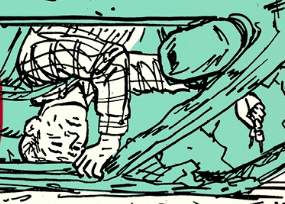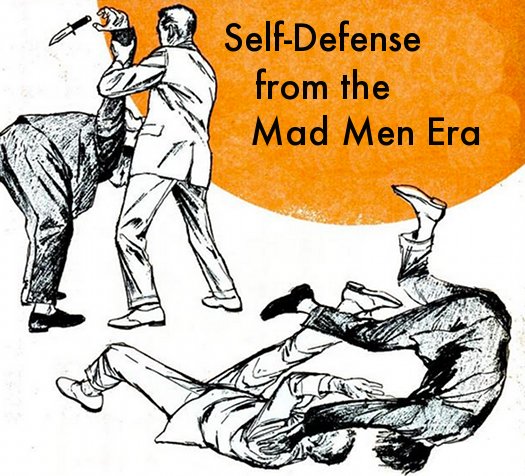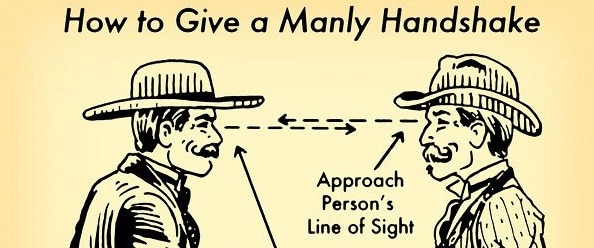
Self-defense is an art that every man should know, not only for protecting himself, but also his friends and family. When it comes to learning this art, there are a wide variety of combat disciplines and systems one can study, and nothing can take the place of training with an experienced coach.
The reality is, however, that sometimes you just might not have the money or time to take up lessons, or you’ve started them, but you’re still pretty green. Given that conflict seldom cares about your budget, schedule, or experience, what should you do if you find yourself in a self-defense situation, without advanced skills for handling it?
Fortunately, there are a few basic, quick-and-dirty tips, which I’ll outline below, that can help give you a bit of an edge.
Please note that these tips should be used as a last resort. While knowing the advice in this guide can help lessen your chances of getting seriously injured in a fight, it’s no match against a properly trained fighter or, even worse, an armed opponent. So please don’t get an undue sense of confidence from this guide.
With that being said, let’s begin our crash course in self-defense.
1. Use your brain and walking shoes first.
Most of the time, you can avoid fights altogether if you just keep a cool head. Keep in mind that any fight can potentially put someone in the hospital or worse; to that end, walking away or using words to deescalate the conflict is often the best defense. So when you make the choice to engage in combat, ask yourself if it’s worth it. Even if you manage to come out on top, you could be looking at heavy legal fines, or the guilt of knowing you caused another person long-term injury, so it’s best to walk away whenever possible. Even better yet is to avoid environments that can put you in antagonistic situations in the first place, such as parties or bars where there might be excessive consumption of alcohol. To repeat the old adage, “Discretion is the better part of valor.”
2. Be aware of your options and your weapons.
Tip #1 should help you avoid around 90% of all fights. But what about the remaining 10%? If negotiations or walking away fail, then it’s time to stand your ground.
One of the best tips is to always remember your attack options. Imagine, for a moment, that someone grabs you by the throat with both hands and starts choking you. This would doubtless be a distressing situation and it’s likely your brain would freeze up. But consider this: both of the attacker’s hands are occupied. Both of your hands are free, not to mention your feet, elbows, knees, and even forehead. His body is wide open and he’s basically a human punching bag at this point. Right now, you could elbow him in the face, knee him in the ribs or groin, stomp on his feet, etc. There are any number of things you can do when attacked, but it’s very easy to get “brain lock” in such situations. By being aware of your attack options, however, you can much more easily find ways to counterattack such aggressors.
One thing about grappling arts like judo and jiu-jitsu is that, while excellent disciplines, they often ignore the concepts of striking. If you ever happen to practice jiu-jitsu, or even watch videos of people doing it, try to think of ways you could strike the face or body if exposed to a certain hold. Of course, certain positions can make your strikes weak and ineffective, tire you out, or cause you to go unconscious before your strikes can do much damage, but it’s still a valuable exercise.
When it comes to striking, it’s also important to keep in mind the concept of proportionality. Joint locks and pins are a means of subduing an opponent without the use of inflicting striking trauma. While a vicious punch to the chops can be an effective counter to a pin, it also carries with it much more potential for damage, and can cause the fight to escalate into further violence or perhaps make you seem like the aggressor in the fight.
Just as striking options should be considered while under attack, so too should movement options. Think about an arm bar, for example (either standing or on the ground). While a skilled fighter will leave little chance of escape, such techniques by less-skilled combatants can be weaseled out of if one moves his body towards the technician rather than trying to pull his wrist and forearm away from the attacker.
Finally, realize that when someone comes at you with both fists swinging, it can cause a lot more shock and surprise than you might realize. If you think that a fight will look like it does in a kung-fu movie or a taekwondo match, where both sides are artfully blocking each other’s attacks and keeping at a comfortable distance, you’re in for a surprise. Most likely, the other guy will come at you like a freight train. This will quash a lot of those blocks and dodges you might be thinking about using. What’s more, it’s really alarming! Your brain is likely to freeze up. Try to keep calm and don’t let it. Now, on the other hand, you can turn this to your advantage by knowing that . . .
3. The best defense is a good offense.
Time for another reality check. In a fight, you’re almost certainly going to get hit. Now, blocking and evading can be valuable skills to have, but they take time and practice to master. Therefore, your best strategy is to hit your opponent faster, harder, and more often than he hits you. And, if he’s someone who’s only practiced karate or more tactical arts, he might be taken off guard by this approach.
On that same note, unless your opponent is substantially bigger than you, try to maintain forward momentum. Again, if you’re trained in fighting, retreating and moving backwards can be helpful, but it will often put you in a defensive situation, where your opponent is free to move forward and possibly bowl you over with his assault. To combat this, maintain your own forward momentum, trying to go towards your opponent. Now don’t be foolish and rush right in blindly: you’ll probably run into his punch or kick. But generally think forwards instead of backwards.
4. Don’t forget lateral movement.
One reason you want to maintain forward momentum is that if you don’t, you might end up getting pushed against a wall. In fact, if your opponent is clever, he’ll actually try to manipulate you into such positions. If, despite your effort to maintain a strong offense and forward momentum, you end up in this position, keep your mind open about your movement choices. Instead of moving backwards into a wall or corner, try to move left or right, circling your opponent. This disrupts his plans and forces him to reposition.
5. Don’t forget to breathe!
With all this aggression, forward movement, and focusing on your strong offense, it’s easy to tense up and use all your energy. This can be bad news. Though it might be easier said than done, try your best not to hold your breath and only use the muscles you need when you need them.
6. Tailor the technique of your punches and kicks.
Kicking and punching is a lot more difficult than the movies make it look.
When it comes to punching, it’s important to know that your hand is full of tiny, articulating bones, and when they collide with one, big, solid bone (like someone’s skull), there’s a pretty good chance some of those little bones will break. If you need to strike, only use punches for soft areas, such as the body or nose (a quick, light jab will do the trick in the latter instance). If you attack the head, think about alternative ways to strike rather than with the knuckles. Open-handed heel-palm strikes allow for much more abuse to your hand and can be adapted to replace a fist in most positions. A hammerfist strike — with the side of the fist — can also be a good alternative.
With kicks: Unless you’re an experienced martial artist, don’t kick above the belt. The balance required, combined with the risk for failure, is too high. Limit your kicks to the legs or the groin.
7. Keep it simple.
“Okay, first, your opponent grabs your lapel. Turn your hand. Now grab his wrist with both your hands. Next turn away from him, pivoting on the balls of your feet. After that you’re going to step under his elbow, pull his arm, then shift your body weight so that he’s moving towards you. Now catch his head with your calf muscle and . . .”
Have you ever seen someone teach this sort of complex technique? Such maneuvers tend to not work so well, and that’s largely because they’re too complicated. A joint lock or hold that’s too complicated causes problems for two reasons.
First, if any “link” in the chain of moves is weak, then the entire technique can fail. When you factor in the different body sizes and levels of strength that you’re likely to encounter, it adds yet another variable.
Second, it requires too much memory and concentration, and when you’re in a fight, those are two things that won’t come easy to you.
In short, complicated techniques usually aren’t worth your time, at least in the context of a street fight. The more simple and boring a technique is, the more reliable it tends to be.
Let’s rewrite that complicated technique above to make it more simple: “Punch the guy in the face until he lets go, then run.” Much easier to remember, right? Of course, it doesn’t have the advantage of being able to put the guy in a position where you can dislocate his arm and stop him completely, but this is a crash course, after all.
8. Learn the basic wrist release.
This is one technique that is actually simple enough to be effective fairly reliably; it’s even effective against jiu-jitsu black belts because it runs on the basic principle of human anatomy that the thumb is extremely weak.
Here’s how it works: Imagine someone grabs your right wrist with his left hand. Simply pivot your hand in a clockwise motion (counterclockwise if he grabs your left wrist with his right hand) and continue the motion in a full circle. This will cause you to move your hand in such a way that the majority of his grip will be concentrated on his thumb, which is too weak to hold your hand. If it doesn’t work, just continue rotating full circle, and continuing to rotate. At some point that hand will come free.
Now, this does take a little bit of practice, and you do have to be able to adapt a bit. This might involve: grabbing the attacker’s own wrist with your free hand, giving your hand a quick jerk to pop it out of his grip, or grabbing the blade of his hand with your free hand and “peeling it off.” Once mastered, however, this move will allow you to free your hand from anyone’s grip.
9. Effectively defend against throws and takedowns.
Be prepared for people to try to take you down. Not only are there judo practitioners out there, but, more commonly, wrestlers, both of whom will try to put you on the ground. Fortunately there are a few simple defenses for this.
The first one is the sprawl. It takes a little practice to get the reflexes down, but with a bit of speed, this is a pretty easy defense. When you see a guy drop towards the ground, he’ll probably try to grab your legs and take you down. When he does this, simply throw your rear back, and let your feet and legs follow, shifting (even jumping a bit, if you prefer) backwards. Meanwhile, you can try to put your hands on his shoulders (which will probably be about the level of your hips at this point) to keep his distance from you, and if his shoulders aren’t there, that’s okay, you’ve still succeeded in getting out of range of his leg grab.
In the event he tries a judo-style hip throw — he’ll actually grab your sleeves or arms, then turn his back to you in an attempt to bring you up on his hips, then dump you on the ground — simply put your hands on his hips and stiffen your arms. It’ll prevent him from getting close to where he can load you on to his back.
Finally, if he has long sleeves, use a “cat’s paw” grip by pinching his sleeve cuffs between your thumb and fingers, then sliding your thumbs back while digging your fingers down into the pocket of fabric it creates. You won’t even need to use your thumbs, as your fingertips will be doing all the work. In this position, push his wrists from the top, down towards the ground, digging your knuckles into the tops of his wrists as you hold the shirt fabric with your fingers. Your back and posture should be straight and upright, with your arms almost locked, “stiff-arming” his arms downward. It shuts down the vast majority of all judo throws, which is why it’s illegal in judo. Just be aware that he can still kick or knee you.
10. Know what to do if someone grabs your leg.
Yes, it happens. Most likely this will occur if you go against someone with wrestling experience and he shoots in for a leg grab (and you fail at sprawling). It can also happen if you kick above the belt, which is too risky a move for most beginners to do, anyway.
If this does happen, don’t panic. Your first instinct might be to just hop around helplessly, but again, keep an open mind, think outside the box, and use all your options. Just because he has your leg doesn’t mean you’re stuck. Go towards your opponent by bending the captured leg at the knee and hopping forward. (Alternatively, if you’re of sufficient strength and size, you can pull him towards you instead.) At this point, you can grab him with your hands, perhaps hooking his neck with one hand and punching with the other, head-butting him, or whatever, until he lets go. Just be aware that he might try to sweep out your remaining leg and take you to the ground. And if that happens, you need to . . .
11. Get off the ground.
While some fighters feel comfortable in a wrestling, ground-fighting position, it’s a whole different ball game, and if you lack experience, it can make you extremely vulnerable.
Once on the ground, you enter a world of complex holds, chokes, and more. You can’t possibly learn all of these without intense study, so instead, remember the tips above; most of them apply on the ground as well. Additionally, try to avoid exposing your back to your opponent, as this opens you to a large number of attacks. In the event you find yourself getting choked, tuck your chin to your neck as hard as you can.
Your ultimate goal is to stand up as soon as possible. One way of doing this is a technique known as a tactical stand-up. This involves, while on your back, planting one hand on the ground along with the foot of the opposite leg, while thrusting your remaining leg and hand out in front of you in order to ward off an approaching attacker, using your extended leg to kick if needed. When you have an opportunity, shift both legs underneath you so you can rise into a standing position. Check out this video, as it can be a valuable skill to know. Alternatively, while lying on your back, you can kick both legs up and over one shoulder, doing a reverse somersault, and coming to your knees, then rising back up.
If all this sounds complicated, it is! That’s why you should try your best to stay off the ground.
Conclusion
There’s no substitution for actual self-defense training. However, by keeping a cool head, using some lateral thinking, and memorizing some simple techniques, you can help tip the odds slightly more in you favor if you suddenly find yourself in a combat situation. Good luck, and stay safe!
______________________
Eric Flynn has been studying various martial arts for thirty years. He has a third-degree black belt in kajukempo and has also studied Brazilian jiu-jitsu, hapkido, iado, Muay Thai, and more. He currently teaches high school English, and writes sword-and-sorcery short stories in his free time, which can be purchased through Amazon.







